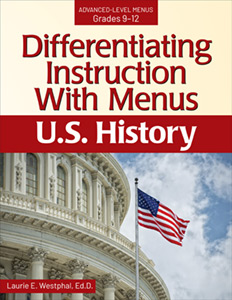Differentiating History Instruction with Menus
Differentiating Instruction With Menus: U.S. History Advanced Level Menus Grades 9-12
By Laurie E. Westphal, Ed.D.
(Prufrock Press, 2020 – Learn more)
Reviewed by Erin Corrigan-Smith

Because of this, and because of dealing with a perceived increase in student apathy, there needs to be an engaging way to increase student buy-in with lessons and projects to help them reach their fullest potential and mitigate any academic losses they received during the pandemic.

Westphal’s book is a comprehensive introduction to student choice and how to make it successful in a high school setting, and it can also work for advanced students in middle school.
This book allows students to work toward their strengths, because the choices allow students to choose their output. By offering students the option to express themselves creatively through art, music, song, or writing, there will naturally be more student engagement and buy-in.
Lots works for middle schoolers, too
Chapter 2 is all about how to use the menus in the book. Think of this as a comprehensive choice book where menus are explained to increase student buy-in. Teachers are walked through the process of best practices for implementation in a variety of academic settings. Though written for high school, each menu is simple enough to work in many middle school classrooms because many of the ideas are generic and can be adapted to suit the needs of today’s learners.
Many teachers may be dissuaded by its high school title, though it lends itself well to the middle school classroom. The menus could be used for unit summarizers to get a quick “temperature check” of how students are feeling about their mastery of the topics discussed in the unit. Students can use the menus for group and for individual work.
Chapter 4 is all about rubrics, and many of the rubrics are included for student self-assessment. Though geared toward teacher use, it is invaluable to have a rubric for students to self-assess during culminating projects and assessments. There is also a section for how to check for Common Core State Standard alignment with different states.
Getting started with choice
The book works well for those classes that cover state history, U.S. Government, and geography topics in class because many of the menus overlap with those subjects. The menus are easily adaptable to different needs, and there are many menus to choose from when modifying.
For any history teacher interested in offering choice but unsure how to begin, this book can be a valuable addition to your teaching reference shelf.
Erin Corrigan-Smith is a middle school ELA teacher in a suburb of Atlanta. She has a B.A. and M.A. in English, and her focus of study is children’s literature. During the school year she is faculty advisor to the Book Worms book club. In her downtime, she enjoys going to her family’s cabin in the North Georgia mountains with her husband and dog to read, craft, and relax.


































